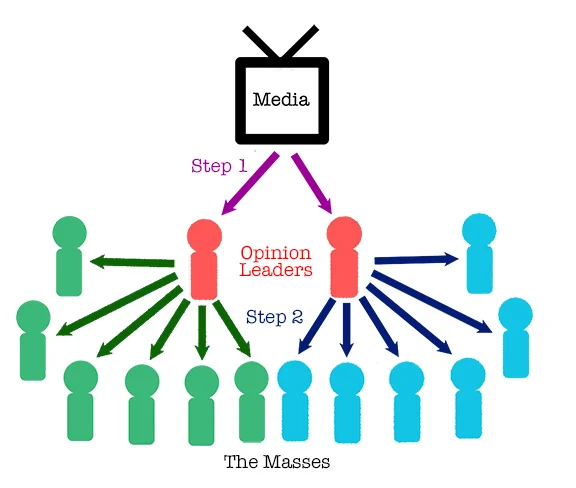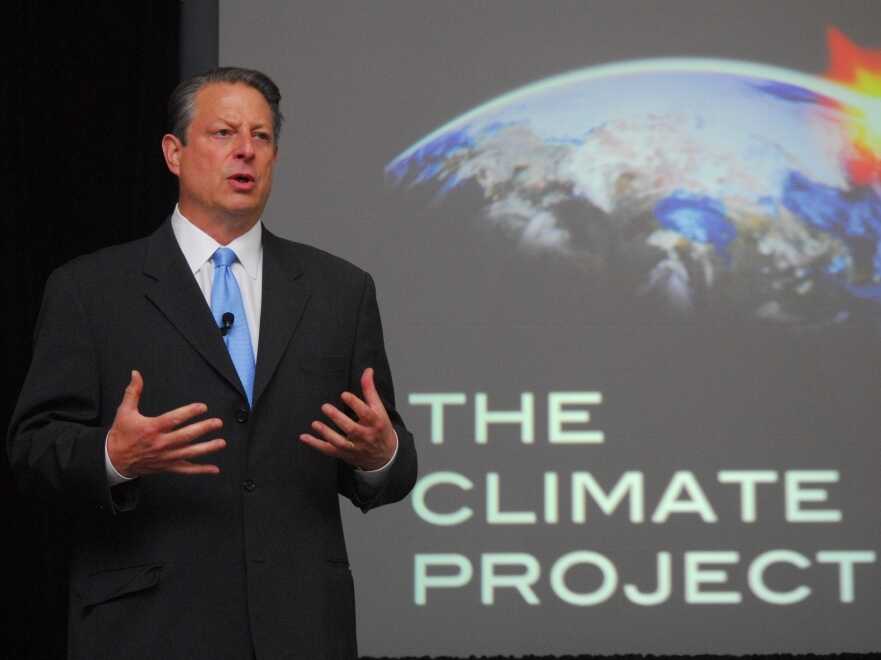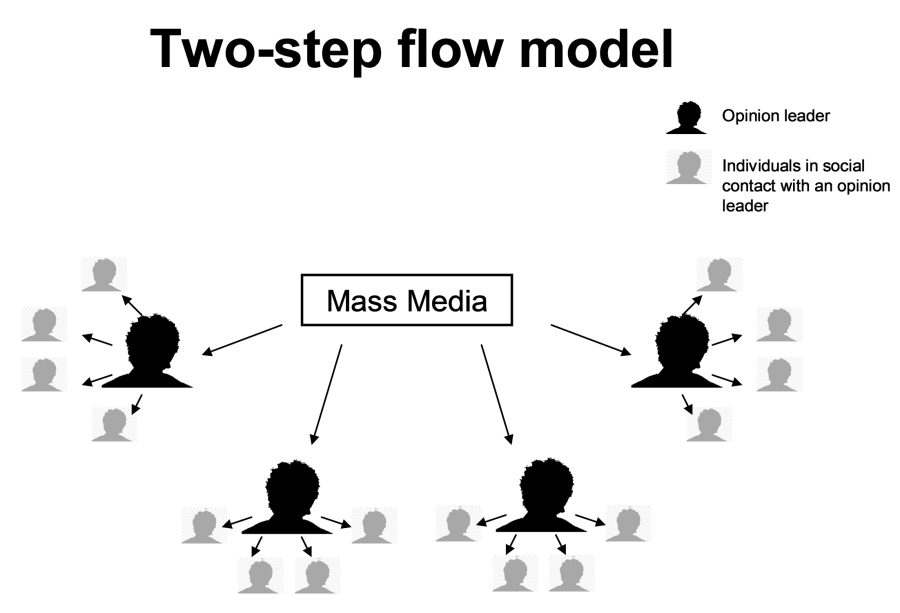Two Step Flow of Communication (referred to as TSFC in the remaining article) is a model created by Paul Lazarsfeld, an Austrian-American sociologist who received his doctorate in Mathematics at the University of Vienna.

According to the concept, most people get their opinions from opinion leaders (such as celebrities or politicians) who themselves are influenced by the mass media. This argues that the media is active while the audience is passive. In 1940, Lazarsfeld’s study of voting behaviour gave rise to TSFC. It changed the prevalent pattern at the time of mass communication. Prior to the study, it was assumed that a mass audience that consumes media messages was directly influenced by the media. People’s decisions and habits were thought to be strongly influenced by the media. However, according to Lazarsfeld’s research, only around 5% of respondents changed their vote as a result of media exposure, and political conversations among friends and family were more common than the consumption of political news in a typical day.
One actual instance of TSFC is Al Gore‘s campaign, the Climate Reality Project. Former US vice president AI Gore gathered leaders to spread awareness of climate change and related policies and to increase his audience. He himself is an opinion leader because he actively participates in the battle against climate change and is a climate change activist. Because of his status and subject-matter knowledge, he has an impact on public opinion.
Marketing is another more broad example of TSFC. To promote their goods and services through sponsorships and endorsements, businesses look for opinion leaders. The firm is then able to reach a bigger audience thanks to the advertisements these leaders make for their followers discussing and reviewing the product.


Another recent example of two-step communication is Prime Minister Rishi Sunak of the United Kingdom’s speech on the Israel-Palestine War, which took place in North London on October 9. Using the TSFC model, we can see that Sunak is a very influential opinion leader whose views are shaped by the global news media and whose speech is directed at his mass audience, which is the UK general public. The viewpoints that the public develops after hearing from their opinion leaders do not, however, always represent the same concepts. For example, many people who watched Sunak’s speech may disagree with his views and claims about supporting Israel. We can prove this as there recently was a Pro-Palestine protest on the 14th of October by the BBC office in Portland Place, London, with future protest events already lined up. This is also known as the ‘oppositional reading’ in Stuart Hall’s Reception theory. This theory states that audiences consume a media product and can interpret it in 3 different ways:
- Dominant reading – where audiences accept the intended messages in the product
- Oppositional reading – where audiences disagree with/reject the intended messages in the product
- Negotiated reading – where they partially accept and partially reject the messages in the text, and adapt it to suit their own beliefs and ideals.
Reference list:
(2023) The Climate Reality Project. Available at: https://www.climaterealityproject.org/ (Accessed: 17 October 2023).
Al Gore (2023) Wikipedia. Available at: https://en.wikipedia.org/wiki/Al_Gore (Accessed: 17 October 2023).
Information theory (no date) Google Books. Available at: https://books.google.co.uk/books?hl=en&lr=&id=3P8poWAeHisC&oi=fnd&pg=PA180&dq=stuart%2Bhall%2Breception%2Btheory&ots=bT7ZnsqbYG&sig=LwxOWYg9yta4EzPPhvEuGV8dtRk&redir_esc=y#v=onepage&q&f=false (Accessed: 17 October 2023).
Paul Lazarsfeld (2023) Wikipedia. Available at: https://en.wikipedia.org/wiki/Paul_Lazarsfeld (Accessed: 17 October 2023).


I like your examples~most of them are in politics, and todayвАЩs political opinion leaders do follow this two-step flow theory, which effectively illustrates the dynamic nature of information dissemination and also increases the modernity of your blog. element. I love the versatility of your analysis of audience and media message responses.
The two step flow theory has been perfectly explained with the help of these examples, but I specifically understood the theory better when you mentioned rishi sunak’s example. A mass audience looks up to the celebrities and big influential personalities and how much impact they have over the audience, but as you mentioned how a huge number of people did not agree to the viewpoints of rishi sunak. I would also like to point out how you differentiated the interpretation of the audience. This definitely helped me understand the theory better.
Hello, Akanksha! Your explanation of the two-step flow model does a great job of combining historical background and real-world applications.The inclusion of Stuart Hall’s Reception theory added a thoughtful layer of nuance. For further exploration, it might be interesting to delve into how the criteria for “opinion leaders” might be evolving in our digital age. I enjoyed your insights!
Hi Akanksha – This was a lovely read, and the current example was very insightful as it is relevant and applicable to our current lives. I also think the video you added was a nice and unique touch to cap off the article and allow the reader to engage on a different level. Although our topics were different, your explanation of Stuart Hall’s Reception theory and Oppositional reading is very similar to my post, as I talked about current opposition to the culture industry’s passivity, concerning the agenda being pushed by the mainstream media themselves. These recent events show just how powerful the media is. I wonder if you feel like the prominent mainstream media outlets themselves can be viewed as “opinion leaders” given the power they hold in shaping the agenda and public opinion towards certain events, such as the Western media’s narrative shaping of the Isreal-Palestine conflict.
Hi Bailey – I do believe to an extent that the social media outlets themselves, and mainstream media platforms like the television industry can be considered ‘opinion leaders. Especially with television news, platforms can change the news information to fit and stand correctly with their political stance, thus altering the opinions and viewpoints of their consumers.